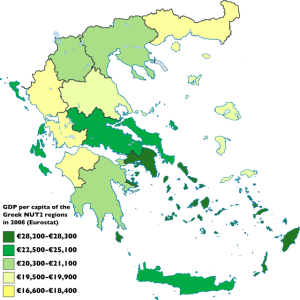As subprime mortgages tanked in May 2007, Ben Bernanke, Chairman of the Federal Reserve, told Congress “At this juncture, however, the impact on the broader economy and financial markets of the problems in the subprime market seems likely to be contained”. Coming at the start of the biggest bust since the Depression he made his name studying, it might be best to take his utterances with a pinch of salt.
So it with his latest, defending the Federal Reserve from charges that its rampant money printing, academically dignified as ‘quantitative easing’, is causing the commodity price rises which, in food prices, helped trigger the unrest that is shaking the Middle East.
Last week Bernanke claimed that his injection of $600 billion dollars into the economy was not inflationary. Commenting on a rise in the United Nations Food and Agriculture Organization’s food price index to 230.7 points from 206 points in November, Bernanke said “Clearly what’s happening is not a dollar effect, it’s a growth effect”
This came soon after Bernstein, a research house whose oil price predictions proved uncannily accurate in 2010, predicted an average price of $90 per barrel over 2011. Cotton prices hit a 150 year high.
Bernanke is surely right that demand pull pressures are playing a role in this. According to the International Energy Agency global oil use is predicted to be 89 million barrels per day this year, up 17% from the 2001 figure of 76 million barrels per day. But the price, $30 per barrel in 2001, has tripled. Plainly something else is also at work.
We have been here before. The 1970’s were famously a decade of rising prices. In 1975 future Nobel Laureate Robert Mundell produced a paper titled ‘Inflation From an International Viewpoint’. He noted that the Bretton Woods arrangement of fixed but variable currencies, in which the dollar was tied to gold at $35 an ounce and other countries fixed to the dollar, had broken down due to excessive pressure on the dollar-gold link by excessive money creation by the Federal Reserve. Realising the weakness of the link holders of dollars began to cash them in for gold. It soon became apparent that there wasn’t enough gold in the US to redeem all these promises so, on August 15th 1971, President Nixon suspended dollar convertibility. Without the ‘wobbly anchor’ of the gold link the Fed’s printing presses could run free.
Almost immediately, as noted by Nathan Lewis in his book ‘Gold – The Once and Future Money’, OPEC members, who priced their oil in dollars, became understandably worried about being paid in increasingly worthless dollars. In September 1971 OPEC resolved
that Member Countries shall take necessary action and/or shall establish negotiations, individually or in groups, with the oil companies with a view to adopting ways and means to offset any adverse effects on the per barrel real income of Member Countries resulting from the international monetary developments of 15th August 1971
Mundell recorded, as quoted in the excellent new book ‘Econoclasts’ by Brian Domitrovic,
Confidence in currencies in general declined and a shift out of money and financial assets commenced. A worldwide ‘scarcity’ of land and…raw materials…emerged. [Soon] the prices of metals, foods and minerals more than doubled. Shortages of beef, sugar and grains appeared, but gold and oil led to the most dramatic ‘crises’ and received the most attention from the public
Sound familiar?
As now, the blame was placed on supply and demand factors. Rocketing oil prices were blamed on the OPEC embargo which followed the Yom Kippur war in 1973. This despite the fact that oil prices had been rising rapidly before the embargo, since, in fact, Nixon’s floating of the dollar. As Lewis notes, following Robert Bartley’s ‘The Seven Fat Years’,
Oil had traded around $2.90 per barrel, or 1/12 ounce of gold, at $35 per ounce. On the eve of the “oil shocks”, with the dollar around $100 per ounce and OPEC still accepting about $2.90 per barrel for oil, the OPEC producers were getting only 1/35 of an ounce of gold for their oil. After they pushed the price to around $10 a barrel in early 1974, with the dollar around $120 per ounce and falling, they were getting around 1/12 ounce of gold for a barrel of oil. OPEC was simply raising its prices, like every other shopkeeper, in response to currency devaluation
CRB futures
The same was true of other commodities. Wheat, corn and soybean prices began rising on the demise of Bretton Woods. As Lewis notes
[OPEC] was actually rather late to the game; prices of most other internationally traded commodities had been rising in response to the sinking dollar since the late 1960’s. There had already been a sharp rise in food prices in 1972 – 1973
This didn’t stop policymakers fishing for explanations in the now discredited ‘Population Bomb’ as they laid the blame for rising oil prices at the door of OPEC. These, Lewis says,
gave the country a popular foreign scapegoat when it’s elites weren’t quite ready to accept the fact that they had brought the disaster upon themselves
As we face similar circumstances now, just pose this simple thought exercise to people: divide the number of dollars in the world by the number of units of a given commodity to get its price. Now double the number of dollars and do the same thing. What happens?
As we’ve noted here before, Keynes once famously wrote
Lenin was certainly right. There is no subtler, no surer means of overturning the existing basis of society than to debauch the currency. The process engages all the hidden forces of economic law on the side of destruction, and does it in a manner which not one man in a million is able to diagnose.
The whirring of Ben Bernanke’s printing press overturning the unpopular regimes of the Middle East. Will it stop there?




